A new kind of battleship
In 1883, the first two ships of this class, Re Umberto and Sicilia, were authorized in parliament by the Finance law. They had been designed by Benedetto Brin, then president of the naval projects committee. In 1885, the parliament also decided to vote for the construction of a third ship, the Sardegna, in order to create a complete squadron.
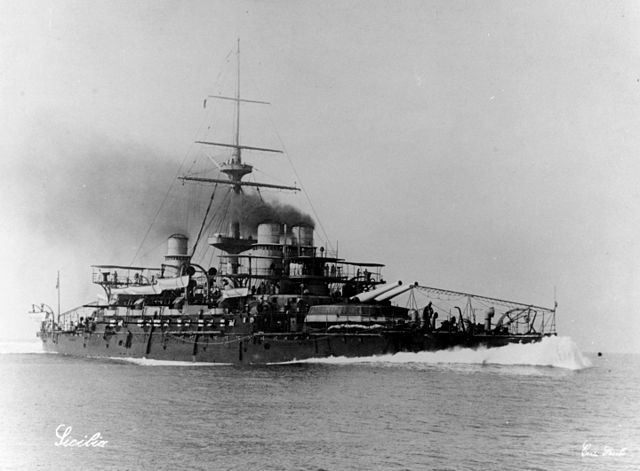
Sicilia, full speed
Design
The Sardegna had for the first time, triple expansion engine and cylindrical boilers. She was heavier by nearly 1000 tons and larger by two meters. In common, they had several unique features: Three chimneys, two of them in tandem, raised barbette/turrets at the fore and aft, a relatively low caliber (343 mm against 430 on the previous Ruggero di Lauria) but fast-firing, at twice the speed of previous gun, with in addition the abandonment of the échelon disposition. The hull was therefore much longer, but stayed low. The Sardegna was also equipped for the first time with a Marconi wireless telegraphic station. All three ships had very thin armor protection and high top speeds.
Career
Re Umberto
Re Umberto served with the two others in the same active squadron for more than 10 years. By 1905 this squadron became the reserve squadron. In fact they were used as training ships as the Italo-Turkish War erupted in 1911.
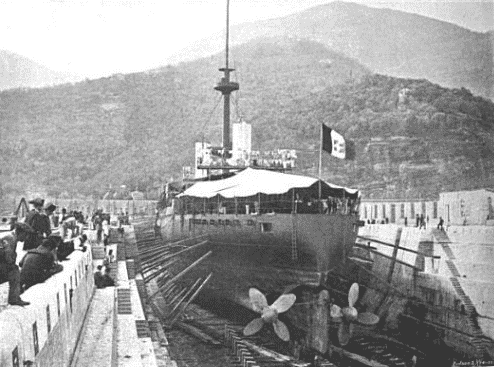
Sardegna in dry dock
In 1912, Re Umberto career was about to end. She was used as a floating tanker at anchor in Genoa. She was badly damaged in May 1914 and after repairs served as a supply vessel for La Spezia from June 1915. She was reactivated in December 1916, recommissioned and converted into a port defense battery at Brindisi and Valone. In 1918, she were once again converted for a final assault of Pola, and was to open the way through mines and nets like a bulldozer, followed by 40 MAS. She was totally disarmed except for eight shielded 76 mm gun, 240 mm Howitzers, but also turrets and bow blades. She was towed to Venice for the raid at the end of October, but the operation was canceled with the armistice and she was struck off in 1920.
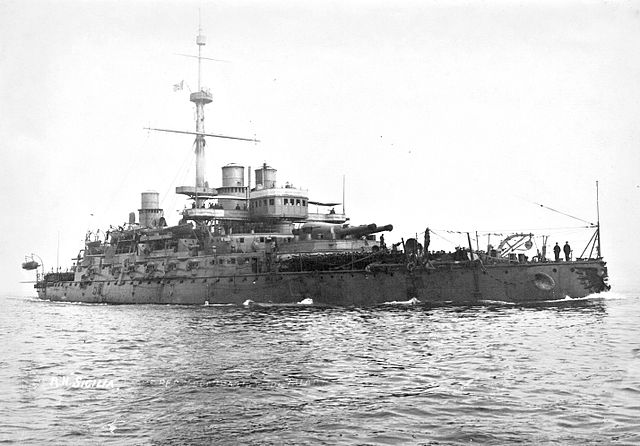
Sicilia, as built.
Sicilia
On her side the Sicilia was reformed in July 1914, but resumed service as a tanker at Taranto, and a Workshop until the end of the conflict. She was destroyed in 1923. However Sardegna and Sicilia supported the Italian left flank and bombarded Tripoli on 23–26 October 1911.
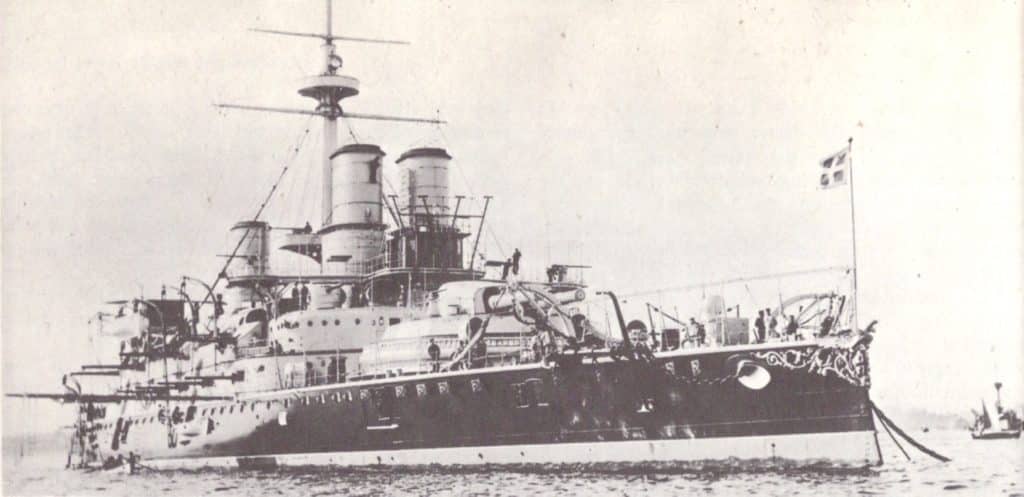
Sardegna starboard size
Sardegna
Sardegna was the flagship of the northern Adriatic fleet, based in Genoa until 15 November 1917, and was sent to Brindisi as a coastal battery, her secondary armament reduced to four 76 mm guns, and 3 heavy machine guns for AA defense. On 10 July 1918 she was transferred to Taranto and then left for Constantinople in 1919, where she remained until 1922. Sicilia was removed from the lists in 1923.
Gallery
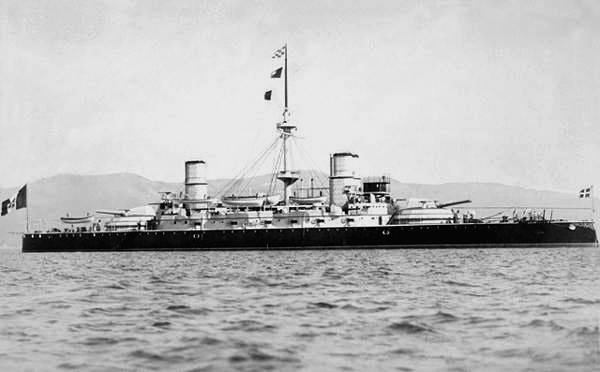
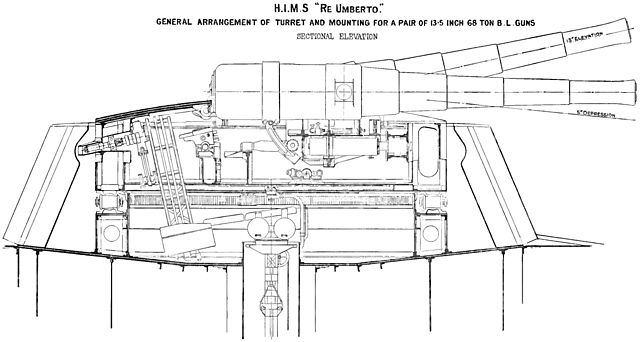
Re Umberto 13.5 in barbette
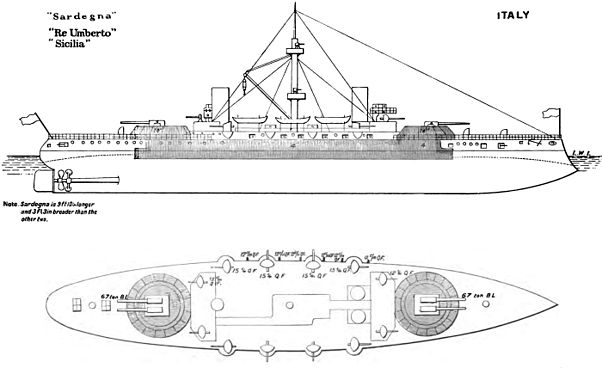
Blueprint – Brasseys 1896.
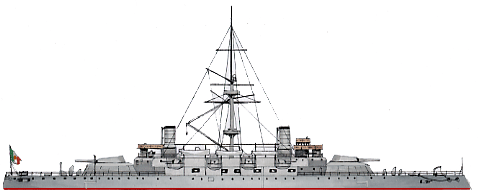
Sardegna in 1914

Re Umberto in 1918
Sardegna (1914) specifications |
|
| Dimensions | Length 130,7 m (428 ft), Beam 20,4 m (67 ft), Draft 8.84 m (29) |
| Displacement | 13,600 T – 15,430 FL |
| Crew | 794 |
| Propulsion | 2 screws, 2 TE engines, 18 boilers, 22 800 hp |
| Speed | 23.3 knots (xx km/h; xx mph) |
| Range | 4,000–6,000 nmi (7,408–11,112 km) |
| Armament | 4 x 343, 8 x 152, 16 x 120, 20 x 57, 10 x 37 mm, 5 TT 450 mm |
| Armor | Belt 102, Deck 76, Blockhaus 300, turret 102, barbettes 350 mm |
Links/Sources
Conways all the world’s fighting ships 1860-1906
en.wikipedia.org/wiki/Re_Umberto-class_ironclad


 Latest Facebook Entry -
Latest Facebook Entry -  X(Tweeter) Naval Encyclopedia's deck archive
X(Tweeter) Naval Encyclopedia's deck archive Instagram (@navalencyc)
Instagram (@navalencyc)





 French Navy
French Navy Royal Navy
Royal Navy Russian Navy
Russian Navy Armada Espanola
Armada Espanola Austrian Navy
Austrian Navy K.u.K. Kriegsmarine
K.u.K. Kriegsmarine Dansk Marine
Dansk Marine Nautiko Hellenon
Nautiko Hellenon Koninklije Marine 1870
Koninklije Marine 1870 Marinha do Brasil
Marinha do Brasil Osmanlı Donanması
Osmanlı Donanması Marina Do Peru
Marina Do Peru Marinha do Portugal
Marinha do Portugal Regia Marina 1870
Regia Marina 1870 Nihhon Kaigun 1870
Nihhon Kaigun 1870 Preußische Marine 1870
Preußische Marine 1870 Russkiy Flot 1870
Russkiy Flot 1870 Svenska marinen
Svenska marinen Søværnet
Søværnet Union Navy
Union Navy Confederate Navy
Confederate Navy Armada de Argentina
Armada de Argentina Imperial Chinese Navy
Imperial Chinese Navy Marinha do Portugal
Marinha do Portugal Mexico
Mexico Kaiserliche Marine
Kaiserliche Marine 1898 US Navy
1898 US Navy Sovietskiy Flot
Sovietskiy Flot Royal Canadian Navy
Royal Canadian Navy Royal Australian Navy
Royal Australian Navy RNZN Fleet
RNZN Fleet Chinese Navy 1937
Chinese Navy 1937 Kriegsmarine
Kriegsmarine Chilean Navy
Chilean Navy Danish Navy
Danish Navy Finnish Navy
Finnish Navy Hellenic Navy
Hellenic Navy Polish Navy
Polish Navy Romanian Navy
Romanian Navy Turkish Navy
Turkish Navy Royal Yugoslav Navy
Royal Yugoslav Navy Royal Thai Navy
Royal Thai Navy Minor Navies
Minor Navies Albania
Albania Austria
Austria Belgium
Belgium Columbia
Columbia Costa Rica
Costa Rica Cuba
Cuba Czechoslovakia
Czechoslovakia Dominican Republic
Dominican Republic Haiti
Haiti Hungary
Hungary Honduras
Honduras Estonia
Estonia Iceland
Iceland Eire
Eire Equador
Equador Iran
Iran Iraq
Iraq Latvia
Latvia Liberia
Liberia Lithuania
Lithuania Mandchukuo
Mandchukuo Morocco
Morocco Nicaragua
Nicaragua Persia
Persia San Salvador
San Salvador Sarawak
Sarawak Uruguay
Uruguay Venezuela
Venezuela Zanzibar
Zanzibar Warsaw Pact Navies
Warsaw Pact Navies Bulgaria
Bulgaria Hungary
Hungary

 Bundesmarine
Bundesmarine Dutch Navy
Dutch Navy Hellenic Navy
Hellenic Navy Marina Militare
Marina Militare Yugoslav Navy
Yugoslav Navy Chinese Navy
Chinese Navy Indian Navy
Indian Navy Indonesian Navy
Indonesian Navy JMSDF
JMSDF North Korean Navy
North Korean Navy Pakistani Navy
Pakistani Navy Philippines Navy
Philippines Navy ROKN
ROKN Rep. of Singapore Navy
Rep. of Singapore Navy Taiwanese Navy
Taiwanese Navy IDF Navy
IDF Navy Saudi Navy
Saudi Navy Royal New Zealand Navy
Royal New Zealand Navy Egyptian Navy
Egyptian Navy South African Navy
South African Navy






























 Ukrainian Navy
Ukrainian Navy dbodesign
dbodesign